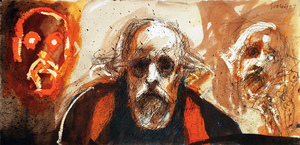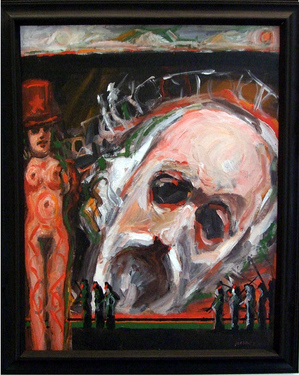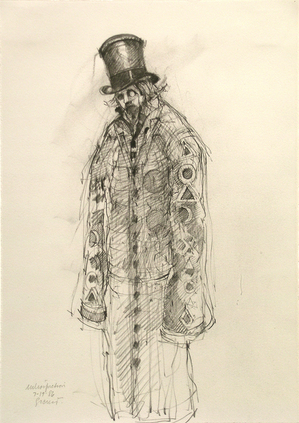This is an archive of the ArtCat Zine, 2007-2009. Please visit our new project, IDIOM.
Tom Secrest at CUE Art Foundation
Tom Secrest
Curated by Trenton Doyle Hancock
CUE Art Foundation - 511 W 25 St, New York NY
31 January - 8 March 2008
In my late teens, I regularly produced drawings of a tall, lean figure dressed in a tail suit and top hat. His facial features were usually obscured, but he glared at the viewer from under a heavy brow. I identified this character as a manifestation of my super ego, and I dubbed him The Observer. I produced at least a hundred such drawings in charcoal or soft-leaded pencil, working the darks into the paper until my fingers blackened. In hindsight, these drawings (and the imagination that spawned them) seem puerile and narcissistic, yet as I made my way around CUE Art Foundation's exhibition of drawings, paintings and prints by Louisiana-based artist Tom Secrest, I recalled that period of self-absorption almost wistfully.
The bulk of Secrest's recent works include a self portrait, either as the central focus or alongside the ghouls, skulls and angels that regularly appear in his compelling pictures. He depicts himself as a morose Shakespeare-type, with a prominent pate, wispy white mane, withdrawn eyes, and, sometimes, a top hat. The images are brooding and often aggressive, rendered with an obsessively graphic sensibility - the paintings, especially, are dominated by reds, and are most concerned with contour and geometry - and bear titles such as Three Sides of the Self, Introspection, Night Dreams, and even The Observer.
The exhibition is thoughtfully curated by the accomplished young artist Trenton Doyle Hancock, who wisely includes a sampling of Secrest's sketchbooks. The pages of these sketchbooks are crowded with heavily worked conte, pastel, charcoal or pencil drawings, and they provide us with a glimpse into what Secrest describes as his "compulsive image making." On a monitor in a corner of the gallery, Hancock displays a video interview with Secrest, as well as a tour of the artist's home studio. These inclusions are significant, emphasizing how thoroughly integrated Secrest's work and creative environment are. On screen, the sixty-five year old artist shuffles down a hallway hung floor to ceiling with artwork (most of it his) and curiosities: a big-eyed alien doll, top hats, masks, skulls and more. According to Hancock, every room is decorated in this fashion; he refers to the house as "a visionary environment." The overall effect is shrine-like, but Secrest's is a tomb-like shrine, dimly lit and silent, excepting the artist's intermittent cough.

Ink wash and line resist on paper, 17 1/2 x 20 1/2 inches
Courtesy CUE Art Foundation
Secrest's cluttered home studio contrasts dramatically with the hotel room in which Hancock conducts the interview. Secrest sits, slump shouldered, in front of a bed and nondescript backboard. The artist is framed by two sconce lamps and a typically forgettable piece of "motel art." His eyes and speech are weary, his beard scraggly. Secrest punctuates his answers to Hancock's questions with hoarse chuckles and occasionally gestures with his left hand. He wears a heavy, ornate ring on his middle finger.
"Isolation has become a major factor in my life," he says. "I didn't do it to myself." But, to some extent, he has done it to himself, and his artist statement admits as much. "Those small pads of paper were the substance which would allow me to escape from my surroundings and to fall into my own form of 'Neverland' or down Alice's rabbit hole. The issue of 'reality' had little interest to me. To be the dreamer and escaping person has long been my way of living." Which came first, we might ask, the isolation or the escapism? The way Secrest speaks of it, he is a victim, a martyr.
Self-portraiture became common practice in the 15th century, when mirrors were made cheaply available. Artists chose to depict themselves because doing so was practical; the artist is his own best model, willing to sit whenever he wants to work. Albrecht Dürer and Rembrandt van Rijn were among the first artists renowned for self-portraits, but it wasn't until the 19th and 20th centuries that an increasingly ego-driven culture accepted certain self-portraits as masterpieces. Vincent van Gogh, Edvard Munch, Egon Schiele and Frida Kahlo, all prolific self-portraitists, were all celebrated for revealing their inner lives, and yet it is difficult to disregard the self-absorption — equal parts self-loathing and self-aggrandizement — that compelled these artists and so many of their contemporaries.

23 x 19 inches, Courtesy CUE Art Foundation
Yet, despite the ascendency of iCulture, self portraits are a relative rarity in the contemporary art world. But perhaps Secrest is just more honest than others about his self-importance. After all, a great many young artists have retreated into the realms of Alice and the Little Prince. Although most do not depict themselves as actors in the fantastic worlds they envision, they are motivated, like Secrest, by a desire to escape real-world anxiety. Hancock's choice of artist is pertinent, then; Secrest is an unsung artistic forebear.
For Secrest, the self-portrait is no effigy. The picture is a fight to manifest the self and a proclamation, "I exist!" As I walk around the CUE exhibition, I wonder if such navel gazing is a product of the time or if the time is a product of our selfish preoccupations.
ZINE
HOME
TIPS / COMMENTS
CATEGORIES
CONTRIBUTORS
- Greg Afinogenov
- B. Blagojevic
- Adda Birnir
- Susannah Edelbaum
- Julie Fishkin
- Paddy Johnson
- Jessica Loudis
- Christopher Reiger
- Andrew Robinson
- Peter J. Russo
- Blythe Sheldon
- S.C.Squibb
- Hrag Vartanian

